‘I have lung cancer, but I’ve never smoked’: Warning to all women
Samantha Bladwell was expecting her second child when diagnosed with lung cancer despite having never smoked. This is what she wants you to know.
QWeekend
Don't miss out on the headlines from QWeekend. Followed categories will be added to My News.
The incline on Brisbane’s Turbot Street is not that steep, not steep enough to render a fit 36-year-old woman breathless. But each day Sam Bladwell made the trek after work, her breathing was more ragged than the day before.
Simple explanation, thought Bladwell. She was 30 weeks pregnant. “It’s just the baby,” she told herself.
But when she puffed her way through a marketing presentation at work with the Queensland Law Society, she decided to see her GP. Probably the baby, he said. But it might be a blood clot. Best get it checked out.
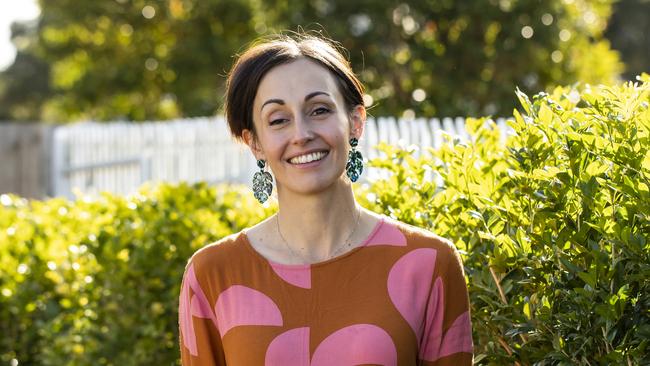
Bladwell remembers how blasé she was about the test. How she wished they’d hurry up with the results of a CT scan so she could get home to her son, Max, then 18 months. How when the doctor came to tell her and husband Cam he wanted to find a quiet place to talk, she thought, “Just find a spot, I’ve got other things to do”.
The untold story of ‘warrior’ Hannah Clarke
‘Call me dad’: Pregnant man takes birth drama to court
Even when cancer was mentioned, she dismissed it. The same with tuberculosis. Not possible. There was talk of a bad infection. That’s what it would be, she decided.
The next day, a host of specialists gathered by her hospital bed. She had cancer. Lung cancer, most likely. Bladwell heard nothing after those words. “It just blew my mind.”
Bladwell was not a smoker. She has never smoked a cigarette in her life. Never. A biopsy showed Bladwell had Stage 4 lung cancer - in both lungs, her spine and her brain.
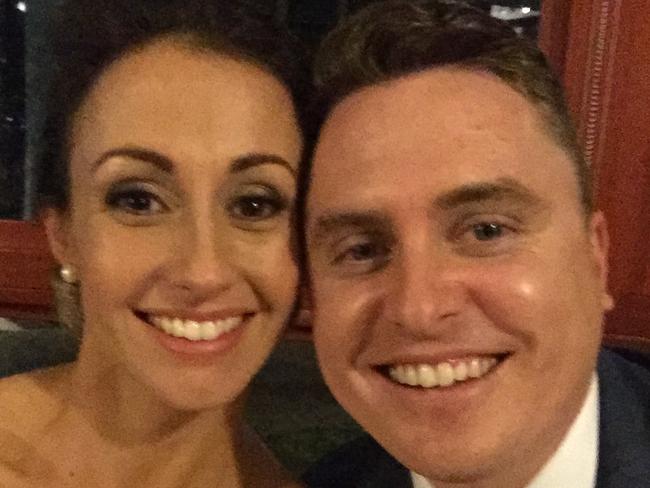
She would soon learn that the incidence of lung cancer in women is increasing, while decreasing in men. Why is unclear, although the fact more women took up smoking in more recent decades is likely a contributor. But Bladwell is a member of another rarely spoken about, poorly understood, cohort: the one in three Australian women with lung cancer who have never smoked. One in 10 men with lung cancer are never smokers, according to Lung Foundation Australia.
“It was a real wake-up call for me to know that if you have lungs, you can get lung cancer,” says Bladwell. “Just as if you have breasts, you can have breast cancer.”
But unlike breast cancer – which sees passionate, high-profile campaigns that have raised billions of dollars for valuable research - lung cancer survival rates have only slightly improved. Research funding for lung cancer is abysmal compared with the burden of the disease. It is the fifth-most-diagnosed cancer in Australia but the one most likely to kill within five years. There’s a 91 per cent chance of living five years after a breast cancer diagnosis. It’s just 17 per cent for lung cancer.
In their own words: Patients tell of living with lung cancer
Bladwell has just clocked up two years since her diagnosis. She’s on her second form of treatment. The little girl Bladwell was carrying at the time of her diagnosis, Cecilia, or CC, is sitting on her lap. Max is inside with his grandparents.
“I’m just trying to get as long as I can on each treatment so that I do get to that five years. And beyond. Significantly beyond,” Bladwell says. “Fifty years would be great.”

BLADWELL had a picture in her mind of a lung cancer patient. They were like her Dad, Allan Murphy. He died at 73 with lung cancer, after more than 50 years of smoking. “I was aware of lung cancer but I was like, ‘This is an old person’s disease, it’s something that happens to people after years of smoking’,” Bladwell, now 38, says on the deck of her home in Murarrie, in Brisbane’s east.
She works in marketing so she has a keen understanding of why that view is so prevalent. The decades-long campaign linking lung cancer to smoking was so good. It was accurate, of course. Smoking is by far the leading cause of lung cancer. But the weight and effectiveness of that message has come at a cost.
“It’s really influenced people’s empathy towards people who have lung cancer,” says Bladwell. “The vision in their mind is that you’ve brought it on yourself so why should I fund any research into lung cancer. It’s really hard to change people’s minds and that’s why I want to share my story to go, ‘Look, it’s not the case and even if it was the case, no-one deserves to have lung cancer’.”
It’s possible passive smoking - either at home with her Dad or socialising - contributed. The question of whether women need lower exposure to smoke to get lung cancer is being studied. But Bladwell grew up on acreage outside Bundaberg, “not in a caravan with all the windows closed”. Her mother Norah and sister Kym are fine. She didn’t spend time in smoke-filled bars – smoking was banned in pubs when she was in her late teens.

Early on, in those tumultuous weeks after diagnosis, Bladwell tracked back through her life, wondering what might have caused her cancer. But she soon decided to concentrate on treating it. “I don’t think I’ve done this to myself,” she says. “I don’t feel like I’m responsible.” But she adds, “I do feel sad about CC, her start to life wasn’t very great”.
CC is busily moving mandarins out of a fruit bowl, as happy and active as a two-year-old should be. But in those traumatic days before her birth, so much information had to be processed by her mother and father, so many tough decisions made. Bladwell needed to begin treatment straight away. But first, CC would have to be delivered prematurely.
The night before the caesarean, a lawyer came to the hospital to organise Bladwell’s will and power of attorney. Then Bladwell recorded her voice onto some teddy bears provided by the charity, Mummy’s Wish. She might not survive. “When I first met the anaesthetist, he said, ‘I don’t know how we’re going to do it because if we put you under, I’m not sure how we’re going to bring you back. And if we do an epidural, we could hit something that’s going to leave you paralysed.
“They had to work out how to do it so that it was most likely not to leave me paralysed or dead.”
CC was born within a week of her Mum’s diagnosis, the placenta tested for cancer cells. All clear. Then CC spent six weeks in the neonatal intensive care unit. She developed bilateral pneumothorax, or as Bladwell puts it “she ended up blowing a hole in both her lungs” – a condition linked to the breathing assistance. She had to be weaned off oxygen and rejected milk formula for a time. “That’s a lot to deal with on its own, let alone having my side of things on top of it.”
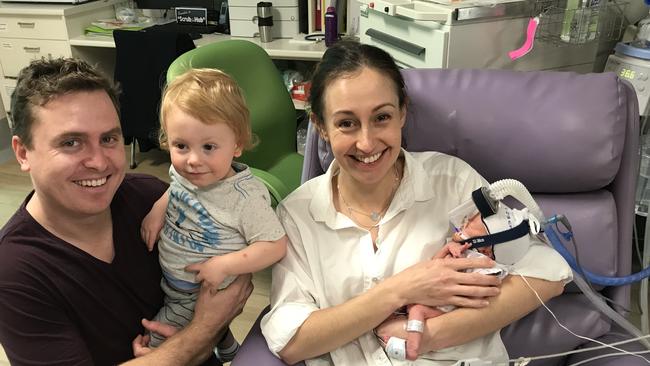
Bladwell’s treatment began the day after CC was born. Surgery was out of the question. “They said, ‘No, there’s no point, it’s everywhere’.” But she was a candidate for targeted therapy, a form of treatment that has grown significantly in the past 20 years, targeting specific genes or proteins that contribute to cancer cell growth, as opposed to chemotherapy which kills normal cells as well as cancerous ones.
Tests showed Bladwell – who has adenocarcinoma, the most common lung cancer among women and non-smokers - had mutations in the epidermal growth factor receptor (EGFR). Other gene mutations that can benefit from targeted therapy include anaplastic lymphoma kinase (ALK) and Ros1.
Within a week of taking one tablet a day, there was a big improvement. Tumours at the base of her lungs had cleared. By January last year, there was no active disease. But targeted therapy has limited efficacy as the cells become resistant. After nine months, the treatment wasn’t working so it was time to find another.
She went onto the Oscillate trial through the Princess Alexandra Hospital, alternating between two different drugs every month. She had almost a year on that treatment until March this year, when she had a seizure while on one of the drugs. She is now taking just the other pill.
She’s hoping to stay on the current regime at least until Christmas. To help reach that goal, she underwent radiation in August for a spot on her brain and has plans for more. “We’ll just try to pick off little spots as they appear until there’s too much to do that,” says Bladwell, whose right eye is now closed due to pressure of a tumour on her optic nerve. “Then I’ll have to have a biopsy and see if there’s another targetable mutation. If not, then probably chemo and immunotherapy.”
After that, treatment options are slim.

More research is key, says Associate Professor Paul Mitchell, a medical oncologist at Austin Health in Melbourne and a member of Lung Foundation Australia’s Lung Cancer Consultative Group. Not enough bright young researchers go into lung cancer research – “It’s never been considered glamorous” - although the relatively recent advent of immunotherapy is generating more interest. And there’s not enough money.
“It’s an issue the world over,” says Mitchell. Lung cancer kills more people but is the worst funded, on a per death basis, compared with other major cancers. A striking graph by Cancer Australia shows the imbalance between research dollars and years of life lost. For lung cancer, the lost years was about 100,000, with direct funding of about $5 million between 2016 and 2018. For breast cancer, it’s about 60,000 with funding of about $25 million; prostate cancer roughly 40,000 to $12 million.
Much of this unevenness has to do with the stigma of the link between smoking and lung cancer; attracting funding from corporations, charities and government for research is “not an easy sell”.
Low survival rates also reflect late diagnosis - the cancer has already metastasised in about half of diagnoses. Mitchell believes screening would help reduce that number. He chairs Cancer Australia’s Lung Cancer Advisory Group, which has been asked by Federal Health Minister Greg Hunt to investigate how a CT screening program could roll out. But the proposed screening would only apply to those 55 years and older with a history of smoking.
“We’re going to have to find other ways to identify younger people at risk,” says Mitchell. Research is being done into identifying gene abnormalities through the breath or blood. “I think we might see something within 10 years.”

Why is there an increase in non-smokers, predominantly women, with lung cancer? “The answer is,” says Mitchell, “we really don’t know.”
There are many lines of investigation. It’s possible women are more susceptible to second-hand smoke than men, says Mitchell. Women of Chinese or south-east Asian ethnicity appear to be more vulnerable, but why is unclear. Asbestos exposure and diesel fumes can play a role. The catch-all “environmental factors” is in the mix. It could be the way women’s bodies, particularly the liver, handle toxins. “There’s a strong theme in terms of females handling toxins somewhat differently to males, whether it’s driven purely by hormonal effects, we don’t know.”
One growing area of research is centred on the fact that genetic abnormalities, such as Bladwell’s EGFR mutation, is found in about 65 per cent of the lung cancer patients who were never smokers, says Mitchell. “That’s what’s driving the cancer at a molecular level but we don’t know what caused the mutation in the first place.” Mitchell says there are newer oral therapies for people with the ALK translocation that tend to be a bit more effective than the EGFR treatments.
“This is a hot area of clinical research and increasingly lab-based research,” says Mitchell. “As we see the cancer outwitting a therapy, then we can try to design new treatments or combinations of treatments to get control of the cancer again.
“Instead of living for 12 months, we have patients living for five years or more,” says Mitchell. “But it’s still not that much for someone who’s young.”
Lisa Briggs is 38. If not for the lifesaving treatment the Melbourne woman received almost six years ago, “I wouldn’t be here today”.
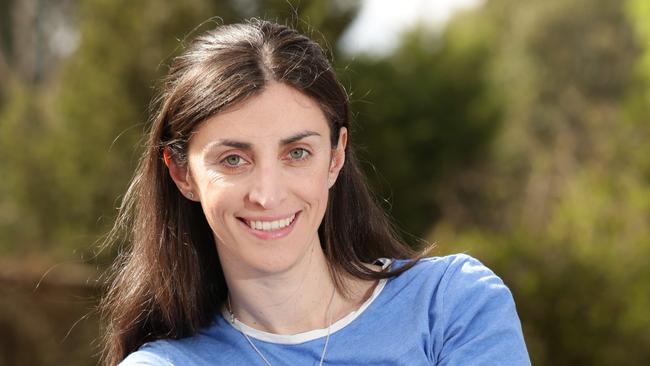
Her diagnosis of lung cancer with the ALK translocation came four months after her son Alastair was born, following a pregnancy plagued by breathing difficulties. Her daughter Jasmine was three. A link to hormonal changes in pregnancy and cancer is also being researched.
“My outcome was grim from the day I was diagnosed,” says Briggs, who needed emergency surgery to stop bleeding in her lungs. “Once that was dealt with, I was able to start treatment and here I am, nearly six years later. And that’s thanks to research; that is thanks to a clinical trial that saved my life.”
The diagnosis of a tumour on her right lung wrapped around her pulmonary artery – and cancer in eight other organs and lymph nodes in her body - astounded her. She’s an exercise physiologist and osteopath who ran her own sports medicine business. She was an ardent non-smoker. If friends were smoking near her, she’d leave the room or ask them to.
“Straight away I was like, ‘How, how can I have lung cancer’?” “But sometimes those answers are not always available.”
Briggs is determined to help find them, and better treatment, and is now an active advocate for lung cancer patients. She believes the longer life span of those who respond well to the genetic-related treatment is helping bring a stronger focus to lung cancer. Briggs is now on her second treatment regime and there is no evidence of tumours in her body, and spots in her brain are stable. Her doctors were surprised she survived three months.
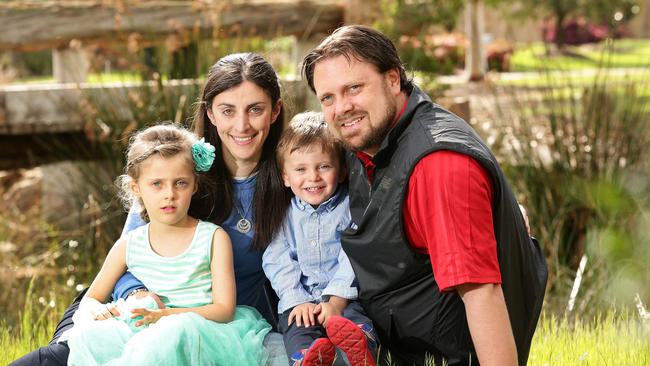
“Research has saved my life and is saving many other lives and with that comes survivorship. And with survivorship comes advocacy. With the other types of lung cancer, where there hasn’t been that research investment and support, they’re not surviving long enough to be able to advocate.”
She wants to make this clear: her advocacy and that of Lung Foundation Australia’s Lung Cancer Patient Advisory Group of which she was an inaugural co-chair, is for all sufferers. Not just non-smokers. “It shouldn’t matter whether you did smoke or not,” says Briggs. “Lung cancer deserves attention and support, no different to any other cancer.”
SOMETIMES, when Sam Bladwell is playing with her kids, probably with trucks if Max is asserting his three-year-old powers, the thoughts tumble in. The good, then the bad. This is really fun, she thinks. “And then I think, ‘But this will not last’.”
“Just for a moment, I think, ‘I don’t want this hanging over my head. I just want to be a normal mum, a normal wife, a normal daughter and friend’. It’s hard to keep your head in the game when you know there is going to be a point where being here is less certain than it is now.”
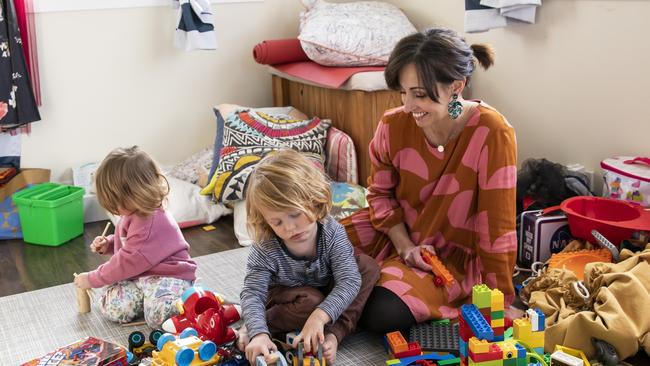
The deaths of friends who were doing well on a treatment “and then suddenly it doesn’t work anymore” hits hard.
“But,” she says, conjuring a big smile, “research is ongoing. It’s my constant mantra. Every time I go to the doctor I ask, ‘What’s new, what’s coming up, what trials are there?’.”
Bladwell is seeing a therapist – as is Cam, 37, - to deal with the shock of the diagnosis and to develop strategies to stay focused on what she can control. There are days when she just wants to cry. “But I have to get up, get the kids’ breakfast. On the days when I feel bad, they make it okay. I have to be up for them.”
Bladwell says her priorities have changed drastically from those days when “I thought I had all the time in the world”. Big holidays, a flash house are not important. “I’m focusing on what’s important to me, which is more the day-to-day, giving my kids a normal life.”
As young Max knows, that includes reinforcement of good manners. His grandmother, Joanne Bladwell, has just asked if the children would like a banana. Max is keen but has forgotten to say “please”. His mum calls out: “Excuse me Max, you say please, please’.”
Joanne takes a seat next to Bladwell and CC, who is happily offering her banana to everyone. Until her daughter-in-law’s diagnosis, Joanne had no idea young non-smokers could develop lung cancer. She’s now a member of a Lung Foundation Australia committee with the aim of educating more people about the risks, the signs and the need for more research funding.
“People need to know this can happen to anyone,” says Joanne. “It’s such a random thing.” Bladwell now knows many younger women who have been diagnosed with lung cancer after connecting through social media. Some, like Briggs, do well and from early on, those are the stories Bladwell has concentrated on. “CC would be asleep in the bassinette and I’d just be Googling,” Bladwell says. “Just constantly looking for people who had done well, or good news, good treatment options to come.”

But there’s a booklet inside that Bladwell is getting around to reading. It’s about talking to kids about cancer. “Max knows I get tired and take my pills every day but we thankfully haven’t had to have a conversation about the end is nigh. Which will be really tough for me to have to do that.”
Her voice falters, the weight of her love and responsibility shaking her composure. She remembers what it’s like to feel carefree and bullet-proof. She knows how easy it is to put things off in a busy life. Please don’t, she says. If you feel breathless, or have a stubborn cough, or you’re always tired, or have ongoing pain in the chest, back or shoulders, get checked.
“I thought I had it all in front of me,” she says. “Now maybe I have some of that in front of me but I don’t have as much as I thought I did.” CC looks up at her and grins. Bladwell smiles back. “But you never know, right?”
THE HARD FACTS ABOUT LUNG CANCER
One in three women diagnosed with lung cancer are never smokers. It’s one in 10 for men.
Lung cancer is the leading cause of cancer death in Australia - more than breast, prostate and ovarian cancers combined.
It has the lowest five-year survival rate (17 per cent) compared with the other top five commonly diagnosed cancers (between 69 and 95 per cent).
In 2018, 5000 men and 3586 women died of lung cancer.
It’s estimated 7278 males and 5813 females will be diagnosed with lung cancer this year.
Lung cancer diagnoses are increasing in women.
Ninety per cent of Australians believe smoking is the only lung cancer risk factor.
One in three Australians believe lung cancer patients “only have themselves to blame”.
SOURCES: Lung Foundation Australia and the Australian Institute of Health and Welfare
